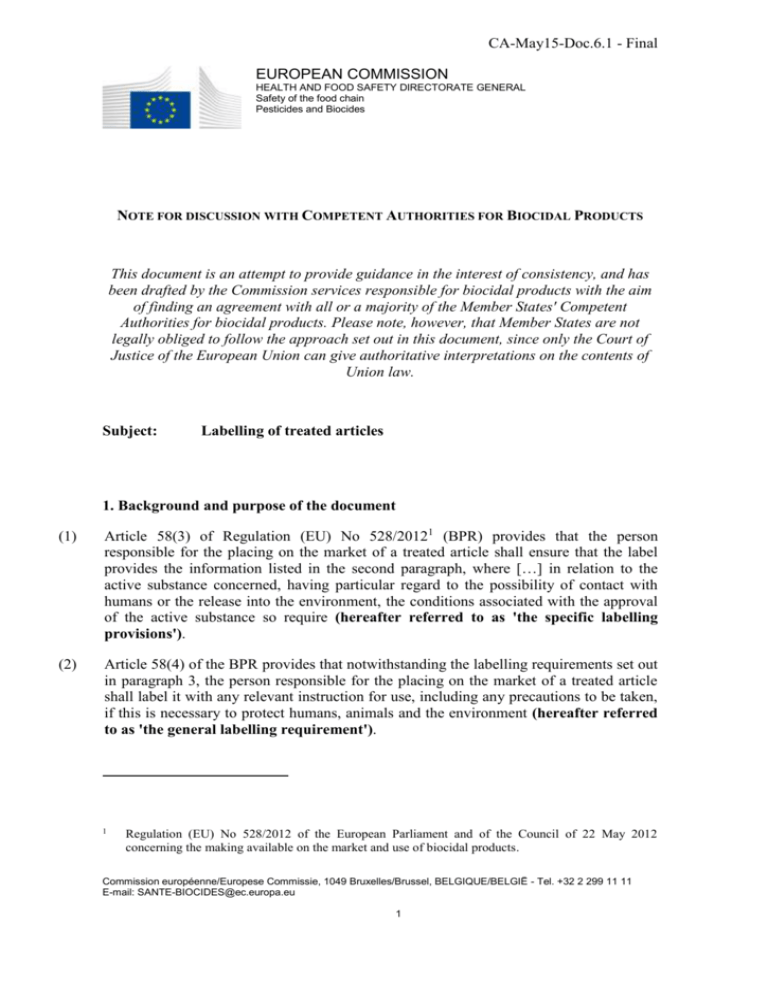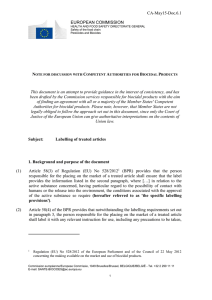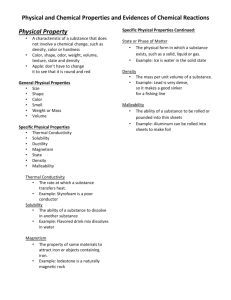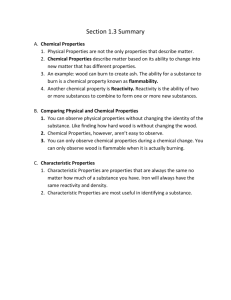Treated articles - CIRCABC
advertisement

CA-May15-Doc.6.1 - Final EUROPEAN COMMISSION HEALTH AND FOOD SAFETY DIRECTORATE GENERAL Safety of the food chain Pesticides and Biocides NOTE FOR DISCUSSION WITH COMPETENT AUTHORITIES FOR BIOCIDAL PRODUCTS This document is an attempt to provide guidance in the interest of consistency, and has been drafted by the Commission services responsible for biocidal products with the aim of finding an agreement with all or a majority of the Member States' Competent Authorities for biocidal products. Please note, however, that Member States are not legally obliged to follow the approach set out in this document, since only the Court of Justice of the European Union can give authoritative interpretations on the contents of Union law. Subject: Labelling of treated articles 1. Background and purpose of the document (1) Article 58(3) of Regulation (EU) No 528/20121 (BPR) provides that the person responsible for the placing on the market of a treated article shall ensure that the label provides the information listed in the second paragraph, where […] in relation to the active substance concerned, having particular regard to the possibility of contact with humans or the release into the environment, the conditions associated with the approval of the active substance so require (hereafter referred to as 'the specific labelling provisions'). (2) Article 58(4) of the BPR provides that notwithstanding the labelling requirements set out in paragraph 3, the person responsible for the placing on the market of a treated article shall label it with any relevant instruction for use, including any precautions to be taken, if this is necessary to protect humans, animals and the environment (hereafter referred to as 'the general labelling requirement'). 1 Regulation (EU) No 528/2012 of the European Parliament and of the Council of 22 May 2012 concerning the making available on the market and use of biocidal products. Commission européenne/Europese Commissie, 1049 Bruxelles/Brussel, BELGIQUE/BELGIË - Tel. +32 2 299 11 11 E-mail: SANTE-BIOCIDES@ec.europa.eu 1 (3) Article 58(2) of the BPR also provides that a treated article cannot be placed on the market unless all active substances contained in the biocidal product used for treating that article are approved for that use. (4) However, even when a substance is approved, there could be conditions restricting the use of that substance. This would happen in case a major concern identified during the substance evaluation, while still making it possible to approve the substance for other uses2: (a) when the concern is limited to a specific use of the substance; or (b) when a substance fulfilling the exclusion criteria set in Article 5(1) of the BPR would benefit from derogation on the basis of Article 5(2) of the BPR. (5) In those circumstances, it will also be important that the treated articles placed on the market and treated with substances the use of which is restricted, are properly labelled. This to ensure that downstream users of the treated articles are made aware of any relevant precaution to be taken to protect humans, animals or the environment. (6) Hence there is need for specific labelling provision in the conditions of approval of certain active substances. (7) At the 58th CA meeting, a note was discussed and endorsed regarding the conditions to be included for treated articles in active substance approvals.3 It was then agreed that a specific labelling provision would be included when the protection of humans, animals and the environment would be better ensured via such a provision and that this would be the case when: (8) (a) a use (or more), among others, of an active substance is eventually restricted because of a major concern and that there would be a need to ensure that the placing on the market of substance, mixtures or articles lawfully treated with that substance for other purposes, do not lead to the same major concern, which was the very reason of the restriction4; (b) the active substance has intrinsic properties that present a serious concern which justifies to enforce a systematic labelling of treated articles in accordance with Article 58(3). The purpose of this note is to provide clear criteria for the implementation of the principles already agreed that specific labelling provisions would be included when the 2 3 4 As agreed at the 55th CA meeting of March 2014. See section 3 of the note on Principles for substance approvals (CA-March14-Doc.4.1) As agreed at the 58th CA meeting. See section 4.2 of the note on Conditions on TA in approvals (CANov14-Doc.6.2) This could for instance be the case of a wood preservative when the approval of the active substance specifies that "Products shall not be authorised for the in situ treatment of wood outdoors, or for wood that will be exposed to weathering", without the possibility to provide additional information at product authorisation to overturn this restriction. In such cases, it would essential for proper implementation hat the labelling of wood treated with such a preservative contain the information that the wood cannot be exposed to weathering, or be used for outdoor constructions. 2 protection of humans, animals and the environment would be better ensured via such a provision. (9) Finally, it is also important to recall that economic operators making treated articles available on the market have a general obligation to place only safe products on the market and to inform consumers of the risks associated with the products they supply, as provided for by the General Product Safety Directive (GPSD) 2001/95/EC5. 2. Suggested criteria (10) Taking into account the above, the implementation of Article 58(3) should be based on criteria that ensure as far as possible an objective, consistent, coherent and proportional approach: 5 6 7 8 9 10 (a) Objective: to provide clear guidance to ECHA and Member States. (b) Consistent: to ensure that substances of similar concerns are treated in the same manner. (c) Coherent: to ensure that the EU chemicals legislation is implemented in a coherent manner. In that respect, it is recalled that: The REACH Regulation6 does not impose labelling requirements for Substances of Very High Concern (SVHC) in articles, whether specific or general7; The CLP Regulation already provides a framework for the labelling of mixtures treated with a biocidal product, which is particularly relevant for active substances to be used as preservatives for mixtures such as product-types 68, 119 or 1310. (d) Proportionality: provisions on treated articles are new and there is therefore little experience of how to implement them. Introducing measures in approvals can lead to many treated articles being labelled without necessarily discriminating between what is of major or serious concern and what is of lesser concern. (e) Enforceability: the measure should be clear to ensure a proper enforcement by both economic operators and control bodies in Member States, and be Directive 2001/95/EC of the European Parliament and of the Council of 3 December 2001 on general product safety (Text with EEA relevance) - OJ L 11, 15.1.2002, p. 4–17 Regulation (EC) No 1907/2006 concerning the Registration, Evaluation, Authorisation and Restriction of Chemicals (REACH). Under REACH, there is not, as such, labelling requirements for articles containing Substances of Very High Concern, but only a duty to communicate sufficient information to the recipient of an article and, upon request, to a consumer to allow safe use of the article, for those articles containing a SVHC above 0.1% w/w. Preservatives for products during storage. Preservatives for liquid-cooling and processing systems. Working or cutting fluid preservatives. 3 equally applicable to imported treated articles and treated articles manufactured in EU. (11) The specific labelling provisions of treated articles should therefore be introduced in the decision to approve a substance under the following conditions: 1) A use (or more), among others, of an active substance is restricted […] and it must be ensured that substance, mixtures or articles lawfully treated with that substance for other purposes, can be placed on the market and used in a manner which do not give rise to the same major concern, which was the ground for the restriction11. 2) Where the active substance meets the exclusion criteria set in Article 5(1), but would benefit from derogation to the exclusion on the basis of Article 5(2)12. 3) The active substance has intrinsic properties13, which […], having particular regard for the possibility of contact with humans or the release to the environment, justify enforcing a systematic labelling of treated articles in accordance with Article 58(3). This would apply to substances having one of the following intrinsic properties: (a) Skin sensitiser14 The active substance meets the criteria to be classified as a skin sensitiser category 1 or sub-category 1A in accordance with Regulation (EC) No 1272/2008. (b) Respiratory sensitiser15 The active substance meets the criteria to be classified as a respiratory sensitizer in accordance with Regulation (EC) No 1272/2008. 11 12 13 14 15 This could for instance be the case of a wood preservative when the approval of the active substance specifies that "Products shall not be authorised for the in situ treatment of wood outdoors, or for wood that will be exposed to weathering", without the possibility to provide additional information at product authorisation to overturn this restriction. In such cases, it would be important to reinforce this ban, and ensure that the labelling of wood treated with such a preservative contain the information that it cannot be exposed to weathering, or be used for outdoor constructions. This would also apply to substances meeting the exclusion criteria but approved on the basis of the BPD because the assessment report was submitted to the Commission before 1 September 2013. As agreed at the 58th CA meeting. See section 4.2 of the note on Conditions on TA in approvals (CANov14-Doc.6.2) This property was selected as there more and more problems of allergies and because providing information, such as the name of the active substance, allow an informed choice for sensitised person. This property was selected as there more and more problems of allergies and because providing information, such as the name of the active substance, allow an informed choice for sensitised person. 4 (c) vP or vB16 The active substance meets the criteria for being very persistent (vP) or very bioaccumulative (vB) according to Annex XIII to Regulation (EC) No 1907/2006 (d) P and B The active substance meets the two criteria for being persistent (P) and bioaccumulative (B) according to Annex XIII to Regulation (EC) No 1907/2006, or (e) Other substances identified as substances of very high concern (SVHC) in accordance with Article 57 of Regulation (EC) No 1907/200617. 3. Suggested wording (12) When one of these conditions is met, the specific labelling provisions will be imposed through the substance approval.18 (13) The conditions of the approval of the active substance will then include the following statement: 'The person responsible for the placing on the market of a treated article treated with or incorporating the active substance X shall ensure that the label of that treated article provides the information listed in the second subparagraph of Article 58(3) of the Regulation (EU) No 528/2012.' (14) As foreseen in Article 58(3) of the BPR, the following information would thus need to be provided on the labelling of articles treated with the substance concerned: (a) a statement that the treated article incorporates biocidal products; (b) where substantiated, the biocidal property attributed to the treated article; (c) the name of all active substances contained in the biocidal products; (d) the name of all nanomaterials contained in the biocidal products, followed by the word ‘nano’ in brackets; 16 17 18 This property was selected as vP and vB substances are very problematic for the environment. This property was selected to ensure a better coherence with REACH, as SVHC under REACH are the equivalent of the substances meeting the exclusion criteria under the BPR and for which, according to paragraph (10)(2) , we would include specific labelling requirements. This could be the case of some specific substances like neurotoxicants, of substances having immunotoxicity or of substances degrading to a CMR. Furthermore, when the first condition is met (i.e. restriction of one or more uses), the substance approval will also indicate how the information on the restricted uses shall be conveyed on the labelling of treated articles. 5 (e) any relevant instructions for use, including any precautions to be taken because of the biocidal products with which a treated article was treated or which it incorporates. (15) The labelling requirements will however not go as far as prescribing the relevant instructions for use, as this will need to be determined on a case by case basis by the person responsible for the placing of the treated articles on the market, taking into account the nature of the risk, if any. (16) However, guidance could be developed in the future to specify the statements that would need to be included in the relevant instructions for use, when the person responsible for the placing of the treated articles on the market concludes that the nature of the risk is such that specific information needs to be passed on to the end-user. (17) For instance, drawing a parallel with the P-statements of the CLP regulation, it could be provided in such a guidance that, if a statement on the disposal of articles treated with a vP substance is needed, then the statement to be used should read19: Dispose of contents/container in accordance with local/regional/national/international regulation (to be specified). 4. Action requested (18) The Commission services invite Member States to take note of this note20. 19 20 By analogy with statement P501 of the CLP Regulation. This note replaces the note on the specific conditions present in the approvals of skin sensitizing active substances related to treated articles (CA-Sept14-Doc.6.3) as well as section 4.2 of the note on Conditions on TA in approvals (CA-Nov14-Doc.6.2) 6








